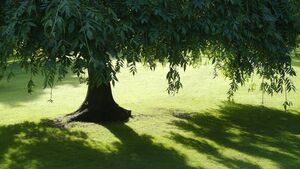Living Greener: Humble willows could solve many problems

Willow Tree soak up a whole load of toxins
EVERY few years the owner of the land next to us clears away the brush, giving us a front-row seat to what biologists call succession. Bare ground is quickly covered with an army of sprouting weeds, the first being the fastest to grow, seed and die, and each new entry grows more slowly and lasts longer. A year or so into the succession the first trees appear, and pioneer trees in Ireland are willows.
Because they are the tree closest to a weed in behaviour, willows – also called sallies, silver-sticks or osiers -- make an amazing resource everywhere they occur, but such thirsty plants do especially well in our wet climate. They can survive an amazing range of conditions, grow so quickly that a new crop of branches up to two to three metres long can be harvested each year – and few trees have as many uses.
Basket-weavers preferred willow over all other plants – the word for willows, “vikker” in Old Norse, became our word “wicker”.
The bark of the white willow (Salix alba) can be boiled to form acetylsalicylic acid, or aspirin. Their fast growth makes an excellent windbreak and makes them particularly useful for pulling carbon from the atmosphere, repairing some of the damage of climate change.
Their roots spread rapidly under the surface of the soil, making them an ideal crop to halt erosion – an important issue in Ireland, where the dramatic felling of the island’s forests over two hundred years washed away much of the soil. Widespread planting of willows back then might have halted some of the erosion that so devastated areas like the Burren.
In addition, the most common willow variety in Ireland, Salix viminalis or “basket willow,” is a hyper-accumulator of heavy metals.
Many plants help “clean” the soil by soaking up disproportionate levels of normally toxic materials, either as a quirk of their metabolism or as a way of protecting themselves against predators by making themselves poisonous.
Many plants soak up only a single toxin, others only a few; Viminalis, it turned out, soaked up a broad range, including lead, cadmium, mercury, chromium, zinc, fossil-fuel hydrocarbons, uranium, selenium, potassium ferro-cyanide and silver.
Willow can also be used for more mundane forms of waste: researcher Alastair McCracken of the Agri-Food and Biosciences Institute of Northern Ireland wrote that his organisation was conducting trials to see how willow can help clean up effluents like sewage sludge and farm manure.
Perhaps most importantly for us in Ireland, however, willow wood makes an excellent fuel, and since the trees can quickly be regrown, the fuel can be 100 per cent sustainable and zero-carbon.
Trees can be coppiced (cut at ground level) or pollarded (cut higher up) to harvest the wood; basket weavers in Ireland would harvest new shoots each winter, getting nine tonnes to the acre in the Midwest USA and ten tonnes here in wetter Ireland.
If the wood is for fuel, though, McCracken recommends a three-year rotation, however, for the maximum yield.
Ireland stands out among European nations: no other country has more potential for biomass production, and no other uses it less. Ireland has the highest potential annual yield of wood in Europe according to the SEI.
Yet Sweden, Germany, Finland, Austria, the UK and even dry Spain manufacture more than ten times the amount of biomass as we do in numbers, and while some of those countries have more area than we do, many also have more population; Britain is many times more crowded than Ireland yet devotes more of its land to growing energy.
Finland gets 18 per cent of its energy from biomass, according to a study by Sustainable Energy Ireland, in contrast with our 1.3 per cent.
In short, one of our commonest and most easily overlooked trees could be the key to solving many of our problems at once.






